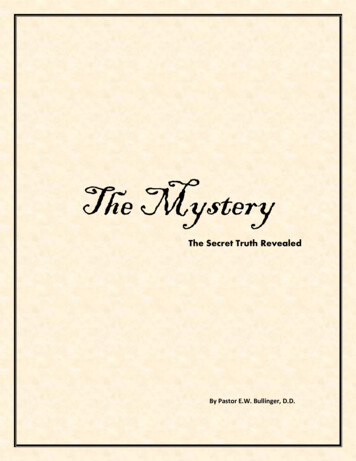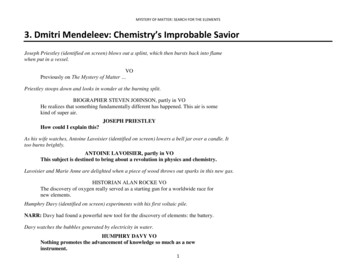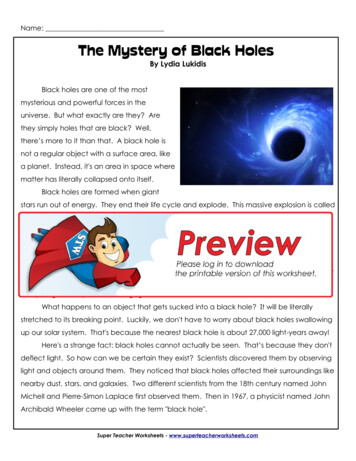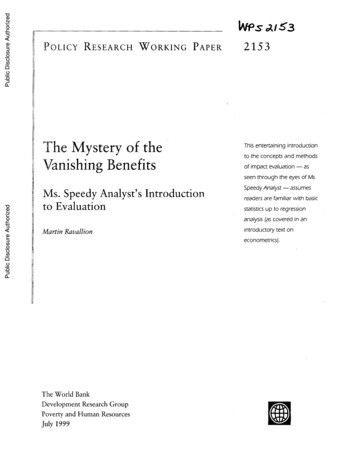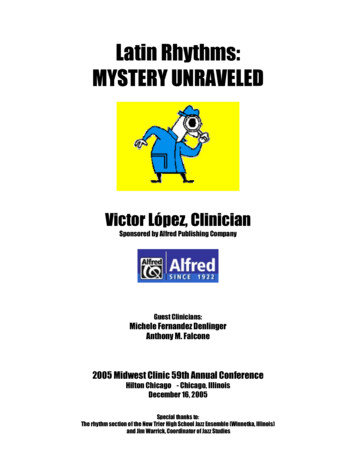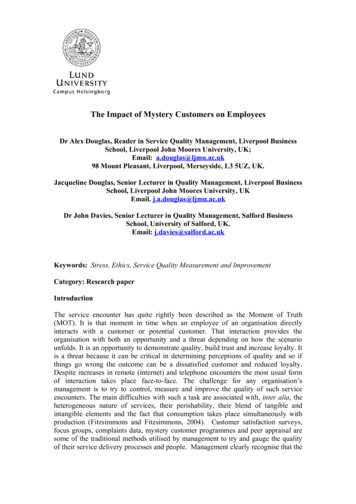
Transcription
The Impact of Mystery Customers on EmployeesDr Alex Douglas, Reader in Service Quality Management, Liverpool BusinessSchool, Liverpool John Moores University, UK;Email: a.douglas@ljmu.ac.uk98 Mount Pleasant, Liverpool, Merseyside, L3 5UZ, UK.Jacqueline Douglas, Senior Lecturer in Quality Management, Liverpool BusinessSchool, Liverpool John Moores University, UKEmail. j.a.douglas@ljmu.ac.ukDr John Davies, Senior Lecturer in Quality Management, Salford BusinessSchool, University of Salford, UK.Email: j.davies@salford.ac.ukKeywords: Stress, Ethics, Service Quality Measurement and ImprovementCategory: Research paperIntroductionThe service encounter has quite rightly been described as the Moment of Truth(MOT). It is that moment in time when an employee of an organisation directlyinteracts with a customer or potential customer. That interaction provides theorganisation with both an opportunity and a threat depending on how the scenariounfolds. It is an opportunity to demonstrate quality, build trust and increase loyalty. Itis a threat because it can be critical in determining perceptions of quality and so ifthings go wrong the outcome can be a dissatisfied customer and reduced loyalty.Despite increases in remote (internet) and telephone encounters the most usual formof interaction takes place face-to-face. The challenge for any organisation’smanagement is to try to control, measure and improve the quality of such serviceencounters. The main difficulties with such a task are associated with, inter alia, theheterogeneous nature of services, their perishability, their blend of tangible andintangible elements and the fact that consumption takes place simultaneously withproduction (Fitzsimmons and Fitzsimmons, 2004). Customer satisfaction surveys,focus groups, complaints data, mystery customer programmes and peer appraisal aresome of the traditional methods utilised by management to try and gauge the qualityof their service delivery processes and people. Management clearly recognise that the
service delivery process is important in relation to customer satisfaction (Wilson,2000).Aims and ObjectivesThis paper seeks to explore the role and use of mystery customers within the contextof customer intelligence gathering. The concept will be described, its perceivedadvantages and disadvantages identified and the impact of their use assessed. Themain aim of this paper is to determine the impact of mystery customers on employeesand their performance to determine whether the reported advantages anddisadvantages of this method of measuring the quality of the service encounter andbeyond are achieved in practice. This main aim will be achieved through the analysisof empirical data collected from a questionnaire survey of employees of one majorUK High Street retailer.Definitions and ScopeMystery Shopping is not new. It was pioneered in the USA in the 1940s, over 60years ago. Today the Mystery Shopping Industry, the focus of this research, is agrowth industry ( 1.5 billion world-wide). The Mystery Shopping ProvidersAssociation has 150 member companies world-wide. More than 8 million MysteryShops were conducted in the USA in 2004 predominantly in retailing, banking andfinance and the fast food sector (www.mysteryshop.org/ 2005). Mystery Customersare used extensively within service organisations within the UK to assess customerservice, monitor front line performance and to benchmark against competitors’performance (Finn and Kayende, 1999). In particular they are used in retailing,banking and financial services, transport services, public services and within thetourism, hospitality and leisure sectors.The Market Research Society (MRS, 2003) defines mystery customers as “individualstrained to experience and measure any customer service process, by acting aspotential customers and in some way reporting back on their experience in a detailedand objective way”.The main aims of Mystery Shopping are:(a)To provide customer intelligence. This has two objectives. Firstly toidentify where people and processes are not performing as theyshould, and secondly to motivate staff by linking performance withrewards and training needs.(b)To provide competitive intelligence by using data collected oncompetitors as a benchmark against which performance can becompared. Indeed some organisations used the data to benchmarkthe performance of different outlets.Harvey (1998) recognises two differing modus operandi. The first uses a professionalwho poses as a customer and evaluates various aspects of the service encounter usinga checklist as an aide memoire. These professionals can either be employed asMystery Customers on a full or part-time basis. In other words their “day job” may besomething completely unrelated. Based on the information noted in the checklist adetailed report is then prepared. The second utilises actual customers who are trainedto make detailed notes based on their shopping encounters that are then handed overto the service management at regular intervals.
Guidelines on mystery shopping (MSPA Europe, 2004) state that such a study should"review how staff and processes perform against pre-determined standards during aninteraction" with the aim of improving both and increasing customer satisfaction.Within the limited literature available on this subject the general consensus is thatoperating mystery customer programmes provides an in-depth insight into customers'perceptions and provides a positive method of service performance measurement thatis welcomed by “good” employees (see for example, Bromage, 2000; Erstad, 1998;Finn and Kayende, 1999; Hesselink and van der Wiele; Leech, 1995; Wilson, 1998;and Zeldis, 1988). Van der Wiele et al (2005) argue that their use can also have apositive impact on organisational changes to the service processes required to deliverexcellence. Collins and Turner (2005) concur and argue that if used correctly mysteryshoppers can produce "fundamental changes in the performance and culture of acompany" if used correctly. This means transparency in their use and with “carrotsrather than sticks”. However, the technique is not without its critics.Methodological IssuesMystery shopping is a form of participant observation, albeit that the observation iscarried out secretly (Calvert, 2005). Jesson (2004) with particular reference topharmacy practice, questions whether mystery shopping techniques aremethodologically sound and ethically and morally justifiable ways of collecting dataon performance. Specifically, the method and sample sizes have been criticised fromreliability and validity aspects. In order for the data to be valid and reliable Hesselinkand van der Wiele (2003) argue that the mystery shopping study has to be welldesigned with particular attention on the process itself, the data gathering process, theperson doing the study (the mystery customer) and the reporting process. Finn andKayende (1999) went further by utilising Cronbach et al's (1972) generalizibilitytheory to recognise that there were a number of variable facets of a mystery shoppingstudy that would impact on the observed performance evaluation, including the timeof day (or night) that the observations were made, the type of transaction beingevaluated, the particular employee being assessed, the process being evaluated and theparticular outlet being studied. They went on to examine the psychometric quality ofmystery shopping data and concluded that the data collected hold up to reliability andvalidity tests particularly when compared to data collected from customer surveys.The issue of generalisability is more contentious and Jesson (2004) argues thatbecause mystery customer methods are context and attitude-free any generalisationsmade do not take into consideration any local situations applying at the time theobservations were made. Collins and Turner (2005) argue that although sample sizesare small each observation is valid in its own right since it is a "snap-shot" of theservice experience at one moment in time and as such is not trying to represent the"population" of all such experiences. Thus for them generalisability is not an issueand the data collected should be analysed within the context it was collected.Ethical IssuesPunch (1994) believes that the subject of research has the right to be informed thats/he is being researched and the nature of that research. In order for the use ofMystery Customers to be ethical, any organisation using them should advise theirstaff that they will be used periodically to check their service delivery performance. Inaddition staff should also be appraised of the objective and intended use of the results
of a mystery customer study. The MSPA guidelines state that any studies "must not beused as the sole reason for dismissals and reprimands" (MSPA Europe, 2004). What ismore problematic is where mystery customers are used to gather competitorintelligence. Competitors' staff do not know they are being observed. Shing andSpence (2002) argue that their use to gather competitive intelligence is akin toindustrial espionage and conclude that in such cases mystery shopping is "difficult todefend ethically".The UK Government in their recent Code of Practice on Consultation (CORIU, 2004)stated that mystery customer programmes can be used to gather specific and detailedfeedback on areas of service and commends it as a simple process, but withlimitations. It is the advantages and disadvantages that are examined in the nextsection.Advantages and Disadvantages of Using Mystery CustomersThe scant literature on the use of the mystery customer concept identifies a number ofadvantages in its use: It enables the evaluation of processes not outcomes, and importantly thisevaluation occurs at the time of the service delivery, i.e. ‘measuring theservice as it unfolds’ (Wilson, 1998). This avoids one of the main pitfalls ofpost-service delivery survey methods, that of ‘misremembering’ by thecustomer. It also enables a ‘customer’ to evaluate the service delivery processwith a view to improving a process that can be seen to actively work againstthe provision of high quality services;It recognises the ‘genuine desire among employees to provide good customerservice’ (Erstad, 1998);It collects facts, not perceptions. The mystery customer questionnaire orchecklist should emphasise objective questions with a view to collectingfactual data, again negating another weakness of customer surveys, i.e. thatcustomers only remember their overall impression of a service and not theindividual elements or transactions (Wilson, 1998);It gathers subjective data as well as objective data (Hesselink and van derWiele, (2003)It is an integral training tool in that it can be used to identify training needs(Bromage, 2000);It can be a positive, motivational tool for employees (Erstad, 1998; Zeldis,1988);It can bring immediate service improvements with continuous improvementpossibilities (CORIU, 2004).Some of the disadvantages include: It can be viewed as threatening to employees, in that staff may view the use ofmystery customers as management checking on their performance with a viewto instigating some form of disciplinary action, rather than as a trigger for stafftraining and development (Erstad, 1998);
It only reviews processes and not their outcomes (Wilson, 1998). This can beproblematic for many services that, as has already been stated, are a mixture oftangible and intangible elements, for example, the restaurant’s service wasexcellent, but the meal itself was substandard;For the employees the novelty of the process can quickly wear off and so anyadvantages may be short-lived (Wilson, 1998);The memory demands placed on assessors could effect the accuracy of thesurveys (Morrison et al, 1997);As with all sampling techniques, it offers only a ‘snapshot’ of the serviceprocess, which may or may not be representative (CORIU, 2004).Research Design and MethodA quantitative survey was undertaken utilizing a questionnaire that was designed,piloted and then administered to employees of a large High Street Retailer across twosites. The self-completion questionnaire contained a mix of closed and multiplechoice questions with a final qualitative question asking for any” further comments”.A total of 73 usable questionnaires were returned from a maximum 75 members ofstaff. Data were analyzed using SPSS v12.The main research questions explored were: Is the use of Mystery Customers an effective means of measuring (andimproving) service quality? Are employees aware that their company uses Mystery Customers? Is this appraisal method viewed as a motivating experience? i.e. leads toimproved performance; Are employees aware of the criteria against which a Mystery Customer willassess their performance? Can employees recognize a Mystery Customer? If so, how does this affecttheir performance? Does the use of Mystery Customers cause employees stress or anxiety? Are Mystery Customer reports used to reward, develop or disciplineemployees?ResultsThe retail outlet employees were predominantly female and aged between 18 and 34years old. Of the 73 respondents 44 worked part-time and 29 worked full-time.Respondents’ positions in the organisation ranged from managerial / supervisorythrough administration to sales assistants.(a)Impact on PerformanceThe vast majority of staff (84%) were aware that Mystery Customers were employedto evaluate individual and outlet performance and 68% of staff were also aware of thecriteria against which their performance would be judged. Perhaps surprisingly only4% of respondents stated that they could recognise / identify a Mystery Customer
when they entered the outlet. Table I below shows the impact that the use andidentification of Mystery Customers has on performance.Impact on performancePerformance improves a lotPerformance improves a littleNo effectPerformance gets worseTable IUse of MysteryMystery CustomersCustomersIdentified / Recognised20%74%77%26%3%0%0%0%The Impact of Mystery Customers on PerformanceHowever, a total of 84% of respondents stated that the use of mystery customers wasa source of stress and anxiety.(b)Mystery Customer ReportsNearly all staff had access to the published Mystery Customer Reports (99%).However, publication of the reports was another cause of stress and anxiety for 85%of respondents. Some staff (18%) had been rewarded based on a good MysteryCustomer report and only one respondent had been disciplined based on a bad report.For most staff (86%) the linking of a good report and rewards acted as a motivator forsuperior performance. Finally, based on a Mystery Customer report, training needshad been identified for 86% of respondents.(c)Employee CommentsOnly four respondents actually took the opportunity to comment via the final openquestion in the survey: “They have a positive effect on standards of service”; “More training should be included”; “We should be told when Mystery Customers are due to come to the store”; “More rewards, incentives and bonuses would boost employees’ opinions”.ConclusionsThe results of this small study show that the organisation under study has to a greaterextent followed the ”best practice” guidelines for the use of mystery customers inevaluating performance. They have made staff aware that Mystery Customers wouldperiodically check their performance. Importantly they also linked the results of themystery customer studies with rewards and training; although one respondent saidthat they had been disciplined due to a bad report. The use of Mystery Customers alsoproduced a limited Hawthorne Effect in that staff said that their use improved theirperformance. However, the most worrying aspect of this study was the fact that theiruse caused staff to be stressed and anxious both at the time of Mystery Customervisits and when the results of their visit were due to be published. Stress may actuallywork against staff giving their best performance, which after all is one of the mainreasons for using mystery customers in the first place. Just how organisations tacklethis problem may be down to organisational culture and management style. Thisseems to conflict with the fact that many staff were motivated at least a little by theuse of Mystery Customers. They are motivated and stressed at the same time. This
would indicate that their culture is one of “carrots and sticks”. Staff are rewarded fordoing well and punished for doing badly and hence are stressed when awaiting theresults of a Mystery Shop. Employees clearly view the use of Mystery Customers as athreat. They may even be afraid of a report citing their poor performance. Also, thefact that the performance of 77% of respondents only improves ”a little” may meanthat the novelty of the process is wearing off and then in order to motivate employeesto even higher performance the organisation’s management may have to rethink theirevaluation strategy. With regards to the main research question - is the use of MysteryCustomers an effective means of measuring service quality? – the answer must be thatit is one way of gathering performance information and should be used alongsideother intelligence gathering methods such as satisfaction surveys and complaintsanalyses to allow factually based management decision-making.LimitationsThis is a very small study conducted on one UK High Street retailer over two sitesand involving only 73 employees therefore it is extremely difficult to generalise theresults. Also the self-completion questionnaire had to be very simple and fast tocomplete in order to maximise the response rate. Improvements to the data gatheringprocess will be difficult as the senior management of organisations using MysteryCustomers are extremely reluctant to allow researchers into their companies to accesstheir employees in order to conduct such studies and this is proving a barrier to morein-depth research and the collection of more valid and reliable data.REFERENCESBromage, N. (2000) Mystery Shopping – It’s research, but not as we know it,Managing Accounting, Vol 78, No.4, pp. 30.Cabinet Office Regulatory Impact Unit, (2004) Code of Practice on Consultation,London.Calvert, P. (2005) It's a Mystery: mystery Shopping in New Zealand's PublicLibraries, Library Review, Vol.54, No.1, pp. 24-35.Collins, J. and Turner, H. (2005) The New Truth about Mystery Shoppers, The WiseMarketer, March, available online at www.thewisemarketer.com accessed 01/11/06.Cronbach, L.J., Goldine, C.G., Harinder, N. and Nageswari, R. (1972) TheDependability of Behavioural Measurements: Theory of Generizability for Scores andProfiles. John Wiley & Sons, New York, cited in Finn, A. and Kayende, U. (1999)Unmasking a phantom: A Psychometric Assessment of Mystery Shopping, Journal ofRetailing, Vol. 75, No.2, pp. 195-217.Erstad, M. (1998) Mystery shopping programmes and human resource management,International Journal of Contemporary Hospitality Management, Vol.10, No.1, pp.34-38.Finn, A. and Kayende, U. (1999) Unmasking a phantom: A Psychometric Assessmentof Mystery Shopping, Journal of Retailing, Vol. 75, No.2, pp. 195-217.
Fitzsimmons, J.A. and Fitzsimmons, M.J. (2004) Service Management: Operations,strategy and Information Technology, McGraw-Hill, New York.Harvey, J. (1998) Service Quality: A Tutorial, journal of Operations Management,Vol.16, pp. 583-597.Hesselink, M. and van der Wiele (2003) Mystery Shopping: In-depth Measurement ofCustomer Satisfaction, ERIM Report Series Research in Management, ERS-2003-20ORG, March.Jesson, J. (2004) Mystery Shopping Demystified: Is it a Justifiable Research Method,The Pharmaceutical Journal, Vol. 272, 15th May, pp. 615-617.Leech, P (1995) The importance of positive customer service to Ansells, ManagingService Quality, Vol. 5, No.4, pp. 31-34.Market Research Society (2003) MRS Code and Guidelines on Mystery CustomerResearch, available online at www.mrs.org.uk, accessed on 6th September 2004.Morrison, L.J., Colman, A.M. and Preston, C.C. (1997) Mystery Customer Research:Cognitive Processes Affecting Accuracy, Journal of the Market Research Society,Vol.39, pp. 349-361.Mystery Shopping Providers Association Europe (2004) Guidelines on MysteryShopping, available online at www.mysteryshop.org/europe, accessed on 20thFebruary 2005.Punch, M. (1994) Politics and Ethics in Qualitative Research, in Denzin, N.K. andLincoln, Y.S. (Eds) (1994) Handbook of Qualitative Research, SAGE, London, pp.83-97.Shing, M.N.K. and Spence, L.J. (2002) Investigating the limits of competitiveintelligence gathering: is mystery shopping ethical? Business Ethics: A EuropeanReview, Vol. 11, No.4, pp. 343-353.Van der Wiele, T., Hesselink, M. and Van Iwaarden, J. (2005) “Mystery Shopping: ATool to Develop Insight into Customer Service Provision, Total Quality Management,Vol. 16, No.4, pp. 529-541.Wilson, A. (2000) The use of performance information in the management of servicedelivery, Marketing Intelligence and Planning, Vol.18, No.3, pp. 127-124.Wilson, A.M. (1998) The role of mystery shopping in the measurement of serviceperformance, Managing Service Quality, Vol. 8, No.6, pp. 414-420.Zeldis, N. (1988) The Phantom shoppers strike again- and again, ManagementReview, June, pp. 10-11.
mystery shopping data and concluded that the data collected hold up to reliability and validity tests particularly when compared to data collected from customer surveys. The issue of generalisability is more contentious and Jesson (2004) argues that because mystery customer methods

